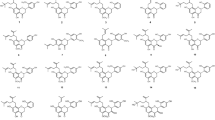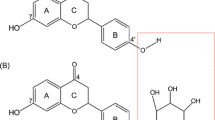Abstract
Antibacterial activities of various flavonoids, a group of natural plant substances, have been reported previously, however, there are contradictory data, published by various authors, regarding sensitivity of particular bacterial species to these compounds. These problems arose apparently because of using different methods by various researchers. Here we tested sensitivity of several bacterial species (Gram-positive: Bacillus subtilis, Micrococcus luteus, Sarcina sp. and Staphylococcus aureus; and Gram-negative: Citrobacter freundii, Escherichia coli, Klebsiella pneumoniae, Proteus vulgaris, Pseudomonas aeruginosa, Salmonella enterica, Serratia marcescens and Vibrio harveyi) to various flavonoids: genistein and daidzein (isoflavones), apigenin (a flavone), naringenin (a flavanone) and kaempferol (a flavonol) by measurement of generation times of bacteria in liquid cultures. The presented results indicate that this simple method is adequate for unambiguous assessment of sensitivity of bacterial strains to flavonoids.
Similar content being viewed by others
References
Aljancic I., Vajs V., Menkovic N., Karadzic I., Juranic N., Milosavljevic S. & Macura S. 1999. Flavones and sesquiterpene lactones from Achillea atrata subsp. multifida: antimicrobial activity. J. Nat. Prod. 62: 909–911.
Anagnostopoulos C.S.J. & Spizizen X.X. 1961. Requirements for transformation in Bacillus subtilis. J. Bacteriol. 81: 741–746.
Azuma Y., Onishi Y., Sato Y. & Kizaki H. 1995. Effects of protein tyrosine kinase inhibitors with different modes of action on topoisomerase activity and death of IL-2-dependent CTLL-2 cells. J. Biochem. 118: 312–318.
Bashir A.K., Abdalla A.A., Wasi I.A., Hassan E.S., Amiri M.H. & Crabb T.A. 1994. Flavonoids of Limonium axillare. Int. J. Pharmacogenet. 32: 366–372.
Belas R., Mileham A., Cohn D., Hilmen M., Simon M. & Silverman M. 1982. Bacterial luminescence: isolation and expression of the luciferase genes from Vibrio harveyi. Science 218: 791–793.
Boege F., Straub T., Kehr A., Boesenberg C., Christiansen K., Andersen A., Jakob F. & Kohrle J. 1996. Selected novel flavones inhibit the DNA binding or the DNA religation step of eukaryotic topoisomerase I. J. Biol. Chem. 271: 2262–2270.
Chang Y.C., Nair M.G. & Nitiss J.L. 1995. Metabolites of daidzein and genistein and their biological activities. J. Nat. Prod. 58: 1901–1905.
Constantinou A., Mehta R., Runyan C., Rao K., Vaughan A. & Moon R. 1995. Flavonoids as DNA topoisomerase antagonists and poisons: structure-activity relationships. J. Nat. Prod. 58: 217–225.
Cushnie T.P.T. & Lamb A.J. 2005. Antimicrobial activity of flavonoids. Int. J. Antimicrob. Agents 26: 343–356.
Erturk O. 2006. Antibacterial and antifungal activity of ethanolic extracts from eleven spice plants. Biologia 61: 275–278.
Furuya E.Y. & Lowy F.D. 2006. Antimicrobial-resistant bacteria in the community setting. Nature Rev. Microbiol. 4: 36–45.
Havsteen B.H. 2002. The biochemistry and medical significance of the flavonoids. Pharmacol. Therapeut. 96: 67–202.
Jensen K.F. 1993. The Escherichia coli “wild types” W3110 and MG1655 have rph frame shift mutation that leads to pyrimidine starvation due to low pyrE expression levels. J. Bacteriol. 175: 3401–3407.
Klein G., Żmijewski M., Krzewska J., Czeczotka M. & Lipińska B. 1998. Cloning and characterization of the dnaK heat shock operon of the marine bacterium Vibrio harveyi. Mol. Gen. Genet. 259: 179–189.
Landa P., Marsik P., Vanek T., Rada V. & Kokoska L. 2006. In vitro anti-microbial activity of extracts from the callus cultures of some Nigella species. Biologia 61: 285–288.
Miski M., Ulubelen A., Johansson C. & Mabry T.J. 1983. Antimicrobial activity studies of flavonoids from Salvia palaestina. J. Nat. Prod. 46: 874–875.
Ohemeng K.A., Schwender C.F., Fu K.P. & Barrett J.F. 1993. DNA gyrase inhibitory and antibacterial activity of some flavones. Bioorg. Med. Chem. Lett. 3: 225–230.
Oksuz S., Ayyildiz H. & Johansson C. 1984. 6-Methoxylated and C-glycosyl flavonoids from Centaurea species. J. Nat. Prod. 47: 902–903.
Parniske M., Ahlborn B. & Werner D. 1991. Isoflavonoid-inducible resistance to the phytoalexin glyceollin in soybean rhizobia. J. Bacteriol. 173: 3432–3439.
Sambrook J., Fritsch E.F. & Maniatis T. 1989. Molecular Cloning: a Laboratory Manual, Cold Spring Harbor Laboratory Press, Cold Spring Harbor, NY.
Snyder R.D. & Gillies P.J. 2002. Evaluation of the clastogenic, DNA intercalative, and topoisomerase II-interactive properties of bioflavonoids in Chinese hamster V79 cells. Environ. Mol. Mutagen. 40: 266–276.
Sun N.J., Woo S.H., Cassady J.M. & Snapka R.M. 1998. DNA polymerase and topoisomerase II inhibitors from Psoralea corylifolia. J. Nat. Prod. 61: 362–366.
Ulanowska K., Tkaczyk A., Konopa G. & Węgrzyn G. 2006. Differential antibacterial activity of genistein arising from global inhibition of DNA, RNA and protein synthesis in some bacterial strains. Arch. Microbiol. 184: 271–278.
Verdrengh M., Collins L.V., Bergin P. & Tarkowski A. 2004. Phytoestrogen genistein as an anti-staphylococcal agent. Microbes Infect. 6: 86–92.
Yamagishi T., Otsuka E. & Hagiwara H. 2001. Reciprocal control of expression of mRNAs for osteoclast differentiation factor and OPG in osteogenic stromal cells by genistein: evidence for the involvement of topoisomerase II in osteoclastogenesis. Endocrinology 142: 3632–3637.
Yazdanyar A., Essmann M. & Larsen B. 2001. Genistein effects on growth and cell cycle of Candida albicans. J. Biomed. Sci. 8: 153–159.
Author information
Authors and Affiliations
Corresponding author
Rights and permissions
About this article
Cite this article
Ulanowska, K., Majchrzyk, A., Moskot, M. et al. Assessment of antibacterial effects of flavonoids by estimation of generation times in liquid bacterial cultures. Biologia 62, 132–135 (2007). https://doi.org/10.2478/s11756-007-0042-3
Received:
Accepted:
Issue Date:
DOI: https://doi.org/10.2478/s11756-007-0042-3




